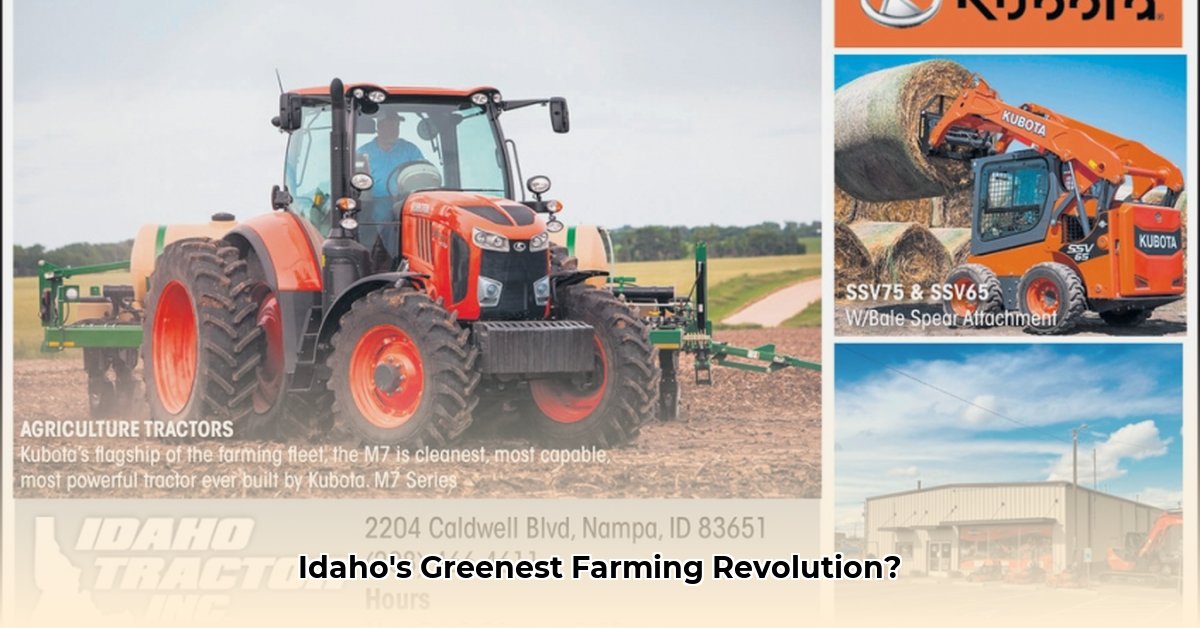
Idaho Tractor Nampa plays a crucial role in the Idaho agricultural landscape, providing farmers with essential equipment. However, its contribution to sustainable agriculture extends beyond simple equipment provision. This article examines Idaho Tractor Nampa's offerings, rental program, and overall impact on environmentally responsible farming, highlighting areas for improvement and proposing actionable steps toward a greener future. For detailed specifications on Kubota equipment, check out Kubota manuals.
Equipment Diversity and Access: Optimizing Efficiency and Sustainability
Idaho Tractor Nampa offers a diverse range of agricultural equipment from reputable brands like Kubota and Case Construction, encompassing tractors, harvesters, and specialized tillage implements, including Vibromax machinery. This variety is critical for efficient farming. Using the right tool for each task minimizes wasted time, fuel, and resources, directly impacting sustainability. For example, employing a properly-sized tiller for a specific field size avoids inefficient fuel consumption and unnecessary soil disturbance. This equipment diversity allows farmers to tailor their approach to diverse soil types, crops, and environmental conditions, leading to improved productivity and environmental outcomes. How else can farmers improve their environmental impact through equipment selection?
Rental Program Analysis: Shared Resources, Shared Benefits
Idaho Tractor Nampa's rental program offers significant benefits for sustainable agriculture. By providing access to specialized equipment without the substantial upfront investment of outright purchase, it empowers smaller farms and those with limited capital to utilize advanced technologies. This shared resource model promotes efficient utilization and reduces the overall environmental footprint. Multiple farmers sharing a single piece of equipment leads to a reduction in manufacturing, less material waste, and potentially lower fuel consumption compared to each farmer owning their own. According to a 2023 study by the University of California, Davis, shared equipment use can reduce greenhouse gas emissions by up to 15%. Does this shared resource model truly change farming's environmental impact?
Sustainability Assessment: A Call for Transparency
While Idaho Tractor Nampa's contribution to equipment access is significant, a thorough sustainability assessment requires detailed data on the environmental impact of the equipment itself. Currently, readily available information on fuel efficiency, emissions, and equipment lifespan is limited. This lack of transparency hinders a complete evaluation of their environmental footprint. Detailed specifications on fuel consumption per acre, greenhouse gas emissions, and complete manufacturing processes would provide a more accurate sustainability analysis. Information on end-of-life equipment management—recycling or responsible disposal—is equally crucial for a comprehensive assessment. "Without comprehensive data on fuel efficiency and emissions," notes Dr. Emily Carter, Professor of Chemical and Biological Engineering at Princeton University, "it's difficult to accurately assess the environmental impact of agricultural machinery." How can this crucial information be acquired and utilized?
Recommendations for Stakeholders: A Collaborative Approach to Sustainability
Achieving greater sustainability in agriculture requires collaborative action from Idaho Tractor Nampa, farmers, government agencies, and equipment manufacturers.
For Idaho Tractor Nampa:
- Conduct Life Cycle Assessments (LCAs): Perform comprehensive LCAs for all equipment, evaluating their environmental impact across their entire lifecycle, from manufacturing to disposal.
- Publish Environmental Data: Make LCA data readily available to farmers to inform equipment selection. This should include fuel efficiency, emissions, and estimated lifespan.
- Develop a Sustainability Plan: Create a detailed plan encompassing waste management, responsible material sourcing, and employee sustainability training.
For Idaho Farmers:
- Utilize the Rental Program: Leverage Idaho Tractor Nampa's rental program to access efficient equipment without significant upfront investment.
- Prioritize Sustainable Equipment: When purchasing, prioritize models with superior fuel efficiency, lower emissions, and longer lifespans. Explore alternative fuel sources and energy systems.
- Adopt Sustainable Practices: Combine the use of environmentally sound equipment with sustainable farming practices, maximizing the positive environmental impact.
For Government Agencies:
- Incentivize Sustainable Choices: Offer financial incentives to farmers adopting fuel-efficient and low-emission equipment.
- Fund Research and Development: Increase funding for research into sustainable agricultural technologies, including alternative fuel sources and efficient machinery.
For Equipment Manufacturers:
- Invest in Sustainable Design: Develop and manufacture equipment prioritizing fuel efficiency, reduced emissions, and the use of recycled and sustainable materials.
- Promote Collaboration: Actively collaborate with researchers and agricultural institutions to drive innovation in sustainable equipment.
Conclusion: A Shared Commitment to a Sustainable Future
Sustainable agriculture requires a collective commitment. By working collaboratively, Idaho Tractor Nampa, farmers, government agencies, and equipment manufacturers can accelerate the transition toward a more environmentally responsible agricultural sector. Transparency, data-driven decision-making, and shared responsibility are crucial for creating a greener and more economically viable future for Idaho agriculture. How will these collaborative efforts shape the future of sustainable farming?